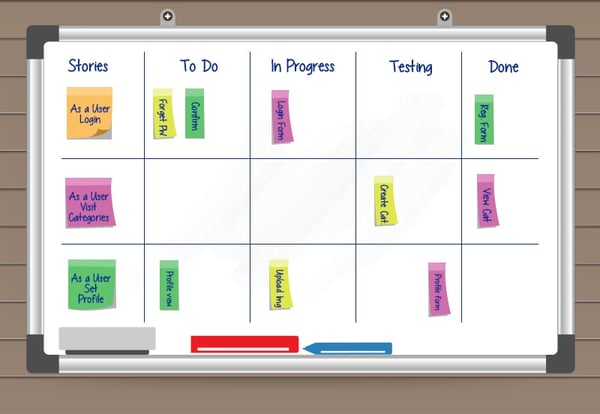As enterprises strive to stay lean and efficient, outsourcing a part or all, of your development process has become a common practice. But it requires a lot of coordination and collaboration between in-house and outsourced teams, to build a great product. And the first step to reaching there is making sure both your onshore and offshore teams have the same method of approaching and handling the project.
One of the industry-wide best practices for software development is to adopt the Agile Scrum Methodology. The team that you outsource to will be, more often than not, an offshore agile team. And so, it’s best that your in-house development team is also well versed in agile. And the best people to aid you in this process are agile coaches, who will understand your business challenges and help you transition accordingly.


And so, we got down to bringing together six great agile coaches, and their take on the various aspect of the transition process. Their ideas and strategies will help you kickstart and manage agile at your enterprise:
Transitioning to Agile
Breaking set patterns and adopting a new way of work can seem difficult at first. But onboarding your team to agile and scrum can actually be a fun exercise.
Stefan Wolpers has a great post where he shares how he transitioned his start-up team to agile and formed scrum team #1. What’s best about this post is that it tells you how to approach the transition process. Starting from why the transition, to identifying current patterns and dysfunctions, to finally forming the first scrum team.
Stefan goes into greater detail, laying down the exact steps to getting your first scrum team. And while the post outlines what he did for a fast growing start-up, the steps wouldn’t be different when you are trying to form the first scrum team at your enterprise.
Evolving Project Managers
Most enterprises have a team of project managers who make sure that all projects are on track. From addressing roadblocks to ensuring delivery, they see to it that the team is working as well as it should. But with agile teams, things work a little differently and so the role of the project manager changes as well.
Mike Cohn adeptly addresses this in his post “The Roles of a Project Management Office in Scrum”. Adopting scrum does away with a lot of a project manager’s conventional responsibilities; assigning them to the ScrumMaster, product owner and the team. But Mike explains that project managers still have a very critical role to play here, especially at large enterprises.
Since enterprises will have a few different projects running simultaneously, there will be various scrum teams in place. Project managers now have the role of facilitating training and ensuring consistency across all teams. Mike’s post is a comprehensive list of all the new responsibilities that project managers now have, to make sure that scrum teams can function effectively.
Managing Scrum Team Challenges
As an enterprise, if you have just started working with the agile scrum methodology, challenges are bound to crop up. It is a new way of work, with new tools and requirements, and there will be a lot of questions and unforeseen problems.
Luis Goncalves shares a great way to address these challenges in his post “How to Manage Organisational Scrum Impediments?” He shares a framework that enables organizations to continuously learn and improve with each project. He shares a tool termed as the ‘Organisational Improvement Board’ and outlines how to use it. Luis shares every step of effectively using this tool, in great detail.
Pivoting at the Right Time
Enterprises usually go large when they start off with a product, investing huge amounts of time and money. There is obviously a lot at stake and building the wrong product can be disastrous. But when you are so involved in building the various parts of a product, it is possible for the team to lose sight of the big picture.
Avienaash Shiralige’s post on “Lean Product Development: Dealing with Business Emergency” tackles this exact problem. He outlines why is essential to include frequent feedback loops in the development process.
But just in case teams realize that they are indeed headed towards the wrong product, Avienaash describes a phase termed the ‘Pivot’. He takes you through the steps of the ‘Pivot’ phase, that will help teams realign their actions with the desired end-product. No new features without validating markets and choosing to hard code some things are a few steps that can help teams get back on track.
Running Effective Retros
In the agile way of doing things, retrospectives are a way of taking stock after each sprint. It’s an important learning tool and helps the teams improve the way it works. Agile coaches can’t stress the importance of this often enough. But the catch is, retros are useful only when done the right way.
And Ben Linders' post on “Retrospective Exercise: Few Vital Actions”, shows you the right way to do it. First up, he lists out some of the critical things that retros should cover. Besides that, Ben also takes you through the value of each of these retrospective actions and how it helps the team become more streamlined and efficient.
Ben also shares another post, “Getting Business Value out of Agile Retrospectives”. This post focuses on how retrospectives can help create value for businesses and customers. Ben lists a set of pointers which will ensure that teams come out of a retro with a set of doable actions for the next sprint.
If you are just starting out with a scrum team, Ben's retrospective exercises will also be a great resource.
Balancing Between Development and Delivery
Agile teams work well because they are quick to respond to changes. Changed requirements are accepted, non-performing strategies are fast discarded, and teams start moving in new directions. But it is a legitimate fear that too many changes, and responding to those, might delay the delivery of anything usable.
Stephanie Ockerman takes up this issue in her post titled “Balancing Emergence and Delivery”. While admitting that it is a tight-rope walk, she looks at three key factors that can cause an imbalance. She then goes on to provide a set of possible solutions that scrum teams can adopt, to ensure that agile development and delivery go hand in hand.
So, this is what some of the best agile coaches have to say about transitioning your enterprise to the agile way of project delivery. If you are already reading up on agile, are there any agile coaches whose ideas you like, but we missed? What are some of your favorite posts on agile?
If you are an enterprise looking to augment your scrum teams, can help you do that. Explore how we can help you scale up your Drupal enterprise teams, and deliver according to the distributed agile models.
Our Services
Customer Experience Management
- Content Management
- Marketing Automation
- Mobile Application Development
- Drupal Support and Maintanence
Enterprise Modernization, Platforms & Cloud
- Modernization Strategy
- API Management & Developer Portals
- Hybrid Cloud & Cloud Native Platforms
- Site Reliability Engineering




